Solutions to Interoperability Challenges in the Health Care System
VerifiedAdded on 2023/05/29
|5
|1105
|462
Report
AI Summary
This report identifies challenges to interoperability in the healthcare system, focusing on issues like inconsistent patient identification, lack of electronic health record adoption, and cybersecurity threats. It proposes solutions such as staff education on system usage, implementing data-sharing systems, enhancing cybersecurity measures, and integrating external data sources into EHRs. The report emphasizes the importance of prioritizing interoperability, assigning patient codes, and addressing information blocking to improve healthcare service delivery. Access this student contributed assignment, along with other resources like past papers and solved assignments on Desklib.
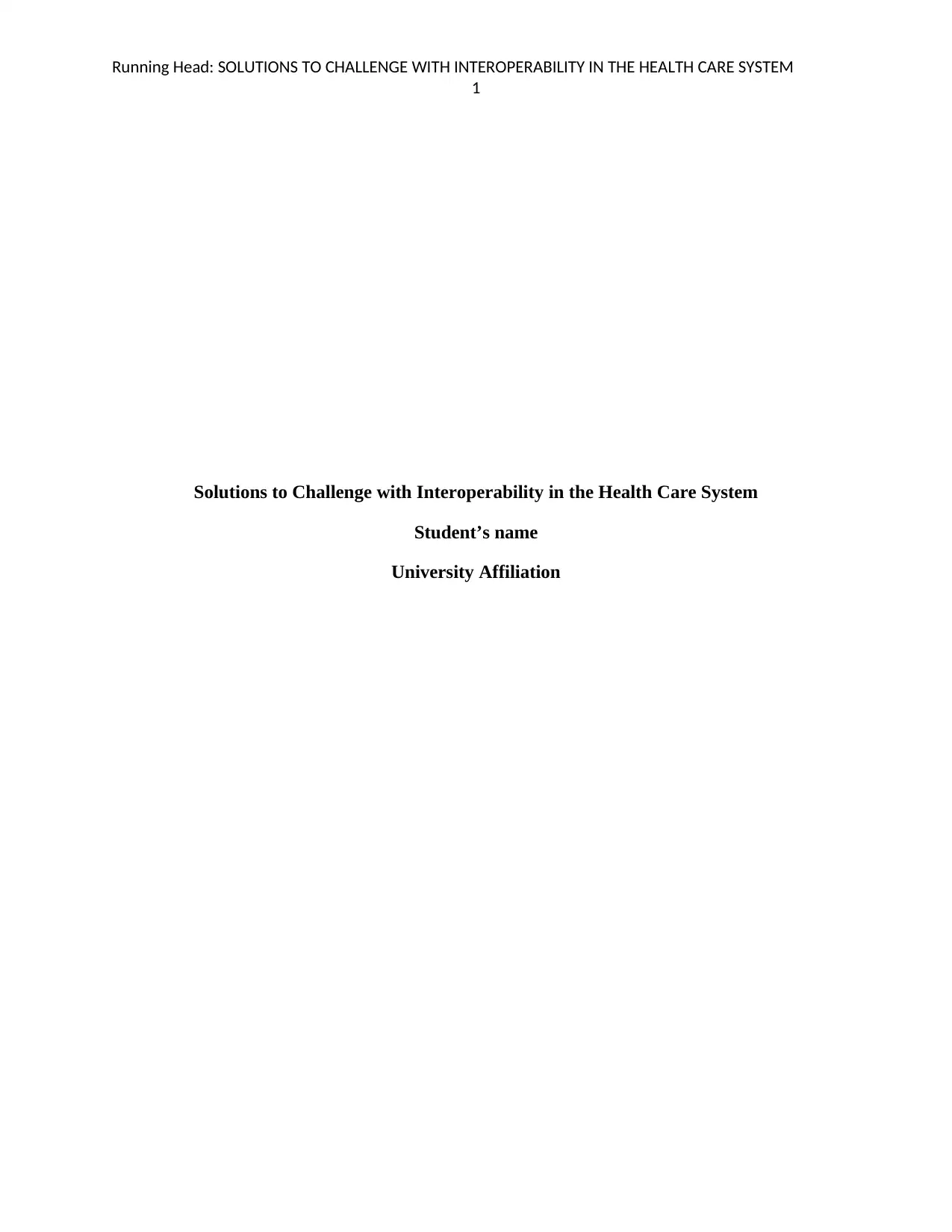
Running Head: SOLUTIONS TO CHALLENGE WITH INTEROPERABILITY IN THE HEALTH CARE SYSTEM
1
Solutions to Challenge with Interoperability in the Health Care System
Student’s name
University Affiliation
1
Solutions to Challenge with Interoperability in the Health Care System
Student’s name
University Affiliation
Paraphrase This Document
Need a fresh take? Get an instant paraphrase of this document with our AI Paraphraser
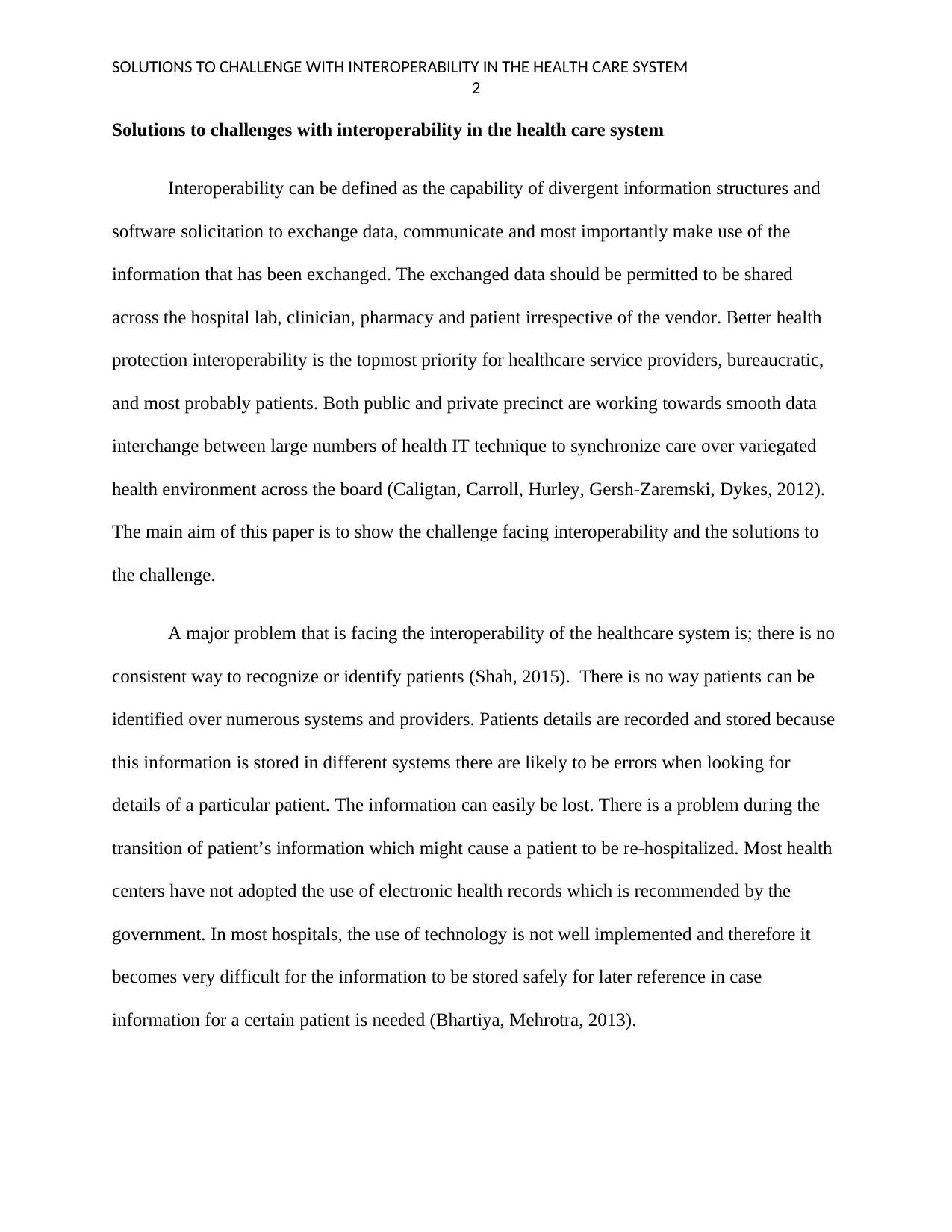
SOLUTIONS TO CHALLENGE WITH INTEROPERABILITY IN THE HEALTH CARE SYSTEM
2
Solutions to challenges with interoperability in the health care system
Interoperability can be defined as the capability of divergent information structures and
software solicitation to exchange data, communicate and most importantly make use of the
information that has been exchanged. The exchanged data should be permitted to be shared
across the hospital lab, clinician, pharmacy and patient irrespective of the vendor. Better health
protection interoperability is the topmost priority for healthcare service providers, bureaucratic,
and most probably patients. Both public and private precinct are working towards smooth data
interchange between large numbers of health IT technique to synchronize care over variegated
health environment across the board (Caligtan, Carroll, Hurley, Gersh-Zaremski, Dykes, 2012).
The main aim of this paper is to show the challenge facing interoperability and the solutions to
the challenge.
A major problem that is facing the interoperability of the healthcare system is; there is no
consistent way to recognize or identify patients (Shah, 2015). There is no way patients can be
identified over numerous systems and providers. Patients details are recorded and stored because
this information is stored in different systems there are likely to be errors when looking for
details of a particular patient. The information can easily be lost. There is a problem during the
transition of patient’s information which might cause a patient to be re-hospitalized. Most health
centers have not adopted the use of electronic health records which is recommended by the
government. In most hospitals, the use of technology is not well implemented and therefore it
becomes very difficult for the information to be stored safely for later reference in case
information for a certain patient is needed (Bhartiya, Mehrotra, 2013).
2
Solutions to challenges with interoperability in the health care system
Interoperability can be defined as the capability of divergent information structures and
software solicitation to exchange data, communicate and most importantly make use of the
information that has been exchanged. The exchanged data should be permitted to be shared
across the hospital lab, clinician, pharmacy and patient irrespective of the vendor. Better health
protection interoperability is the topmost priority for healthcare service providers, bureaucratic,
and most probably patients. Both public and private precinct are working towards smooth data
interchange between large numbers of health IT technique to synchronize care over variegated
health environment across the board (Caligtan, Carroll, Hurley, Gersh-Zaremski, Dykes, 2012).
The main aim of this paper is to show the challenge facing interoperability and the solutions to
the challenge.
A major problem that is facing the interoperability of the healthcare system is; there is no
consistent way to recognize or identify patients (Shah, 2015). There is no way patients can be
identified over numerous systems and providers. Patients details are recorded and stored because
this information is stored in different systems there are likely to be errors when looking for
details of a particular patient. The information can easily be lost. There is a problem during the
transition of patient’s information which might cause a patient to be re-hospitalized. Most health
centers have not adopted the use of electronic health records which is recommended by the
government. In most hospitals, the use of technology is not well implemented and therefore it
becomes very difficult for the information to be stored safely for later reference in case
information for a certain patient is needed (Bhartiya, Mehrotra, 2013).
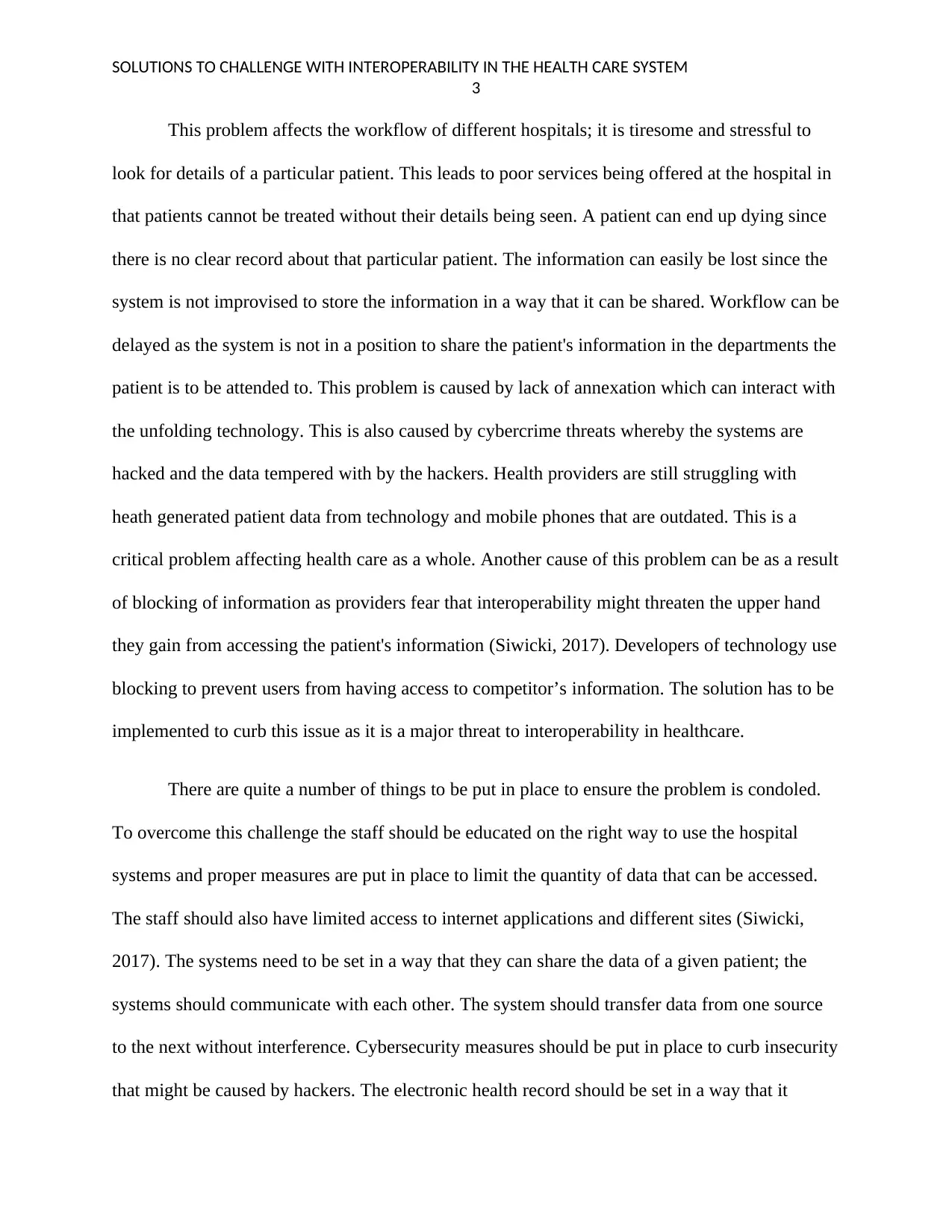
SOLUTIONS TO CHALLENGE WITH INTEROPERABILITY IN THE HEALTH CARE SYSTEM
3
This problem affects the workflow of different hospitals; it is tiresome and stressful to
look for details of a particular patient. This leads to poor services being offered at the hospital in
that patients cannot be treated without their details being seen. A patient can end up dying since
there is no clear record about that particular patient. The information can easily be lost since the
system is not improvised to store the information in a way that it can be shared. Workflow can be
delayed as the system is not in a position to share the patient's information in the departments the
patient is to be attended to. This problem is caused by lack of annexation which can interact with
the unfolding technology. This is also caused by cybercrime threats whereby the systems are
hacked and the data tempered with by the hackers. Health providers are still struggling with
heath generated patient data from technology and mobile phones that are outdated. This is a
critical problem affecting health care as a whole. Another cause of this problem can be as a result
of blocking of information as providers fear that interoperability might threaten the upper hand
they gain from accessing the patient's information (Siwicki, 2017). Developers of technology use
blocking to prevent users from having access to competitor’s information. The solution has to be
implemented to curb this issue as it is a major threat to interoperability in healthcare.
There are quite a number of things to be put in place to ensure the problem is condoled.
To overcome this challenge the staff should be educated on the right way to use the hospital
systems and proper measures are put in place to limit the quantity of data that can be accessed.
The staff should also have limited access to internet applications and different sites (Siwicki,
2017). The systems need to be set in a way that they can share the data of a given patient; the
systems should communicate with each other. The system should transfer data from one source
to the next without interference. Cybersecurity measures should be put in place to curb insecurity
that might be caused by hackers. The electronic health record should be set in a way that it
3
This problem affects the workflow of different hospitals; it is tiresome and stressful to
look for details of a particular patient. This leads to poor services being offered at the hospital in
that patients cannot be treated without their details being seen. A patient can end up dying since
there is no clear record about that particular patient. The information can easily be lost since the
system is not improvised to store the information in a way that it can be shared. Workflow can be
delayed as the system is not in a position to share the patient's information in the departments the
patient is to be attended to. This problem is caused by lack of annexation which can interact with
the unfolding technology. This is also caused by cybercrime threats whereby the systems are
hacked and the data tempered with by the hackers. Health providers are still struggling with
heath generated patient data from technology and mobile phones that are outdated. This is a
critical problem affecting health care as a whole. Another cause of this problem can be as a result
of blocking of information as providers fear that interoperability might threaten the upper hand
they gain from accessing the patient's information (Siwicki, 2017). Developers of technology use
blocking to prevent users from having access to competitor’s information. The solution has to be
implemented to curb this issue as it is a major threat to interoperability in healthcare.
There are quite a number of things to be put in place to ensure the problem is condoled.
To overcome this challenge the staff should be educated on the right way to use the hospital
systems and proper measures are put in place to limit the quantity of data that can be accessed.
The staff should also have limited access to internet applications and different sites (Siwicki,
2017). The systems need to be set in a way that they can share the data of a given patient; the
systems should communicate with each other. The system should transfer data from one source
to the next without interference. Cybersecurity measures should be put in place to curb insecurity
that might be caused by hackers. The electronic health record should be set in a way that it
⊘ This is a preview!⊘
Do you want full access?
Subscribe today to unlock all pages.

Trusted by 1+ million students worldwide
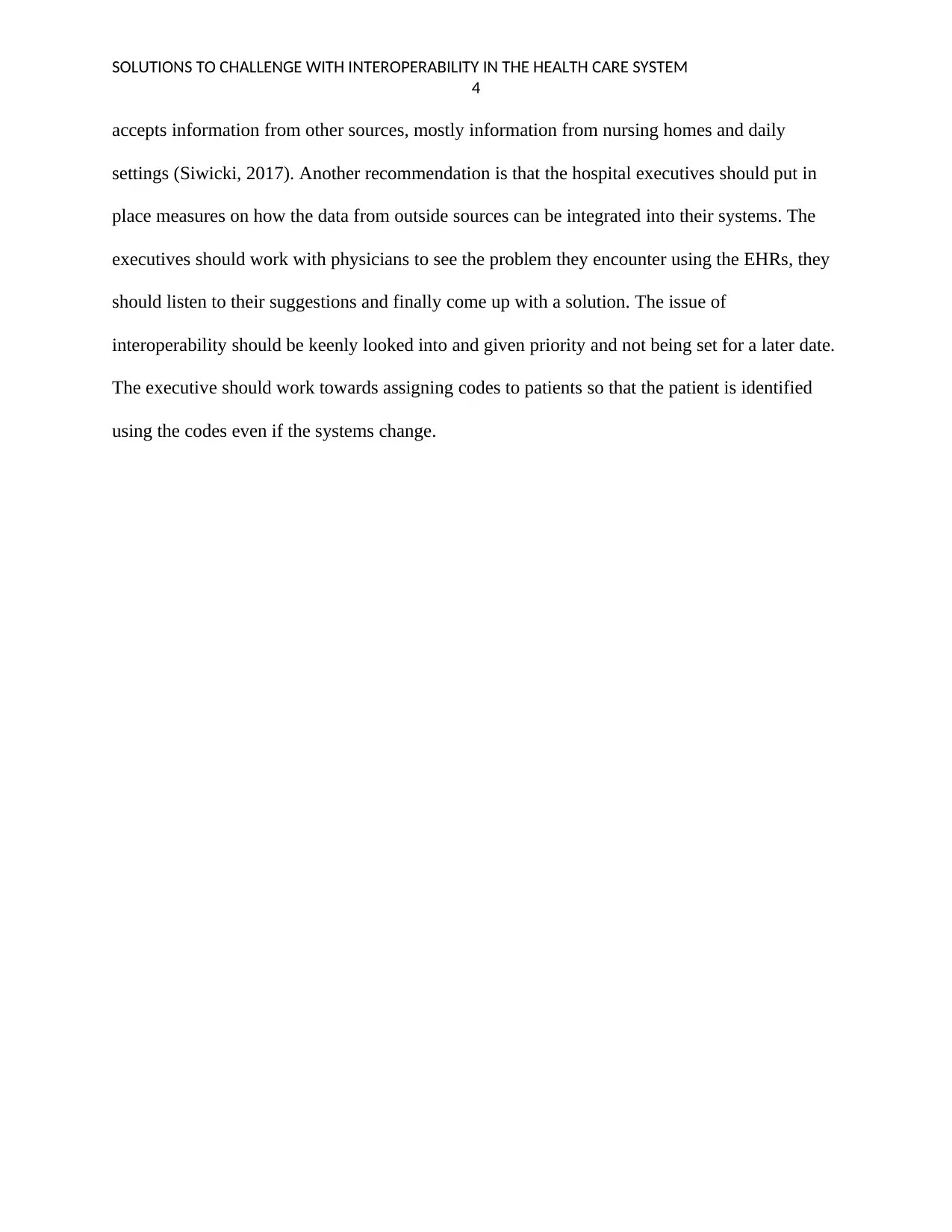
SOLUTIONS TO CHALLENGE WITH INTEROPERABILITY IN THE HEALTH CARE SYSTEM
4
accepts information from other sources, mostly information from nursing homes and daily
settings (Siwicki, 2017). Another recommendation is that the hospital executives should put in
place measures on how the data from outside sources can be integrated into their systems. The
executives should work with physicians to see the problem they encounter using the EHRs, they
should listen to their suggestions and finally come up with a solution. The issue of
interoperability should be keenly looked into and given priority and not being set for a later date.
The executive should work towards assigning codes to patients so that the patient is identified
using the codes even if the systems change.
4
accepts information from other sources, mostly information from nursing homes and daily
settings (Siwicki, 2017). Another recommendation is that the hospital executives should put in
place measures on how the data from outside sources can be integrated into their systems. The
executives should work with physicians to see the problem they encounter using the EHRs, they
should listen to their suggestions and finally come up with a solution. The issue of
interoperability should be keenly looked into and given priority and not being set for a later date.
The executive should work towards assigning codes to patients so that the patient is identified
using the codes even if the systems change.
Paraphrase This Document
Need a fresh take? Get an instant paraphrase of this document with our AI Paraphraser
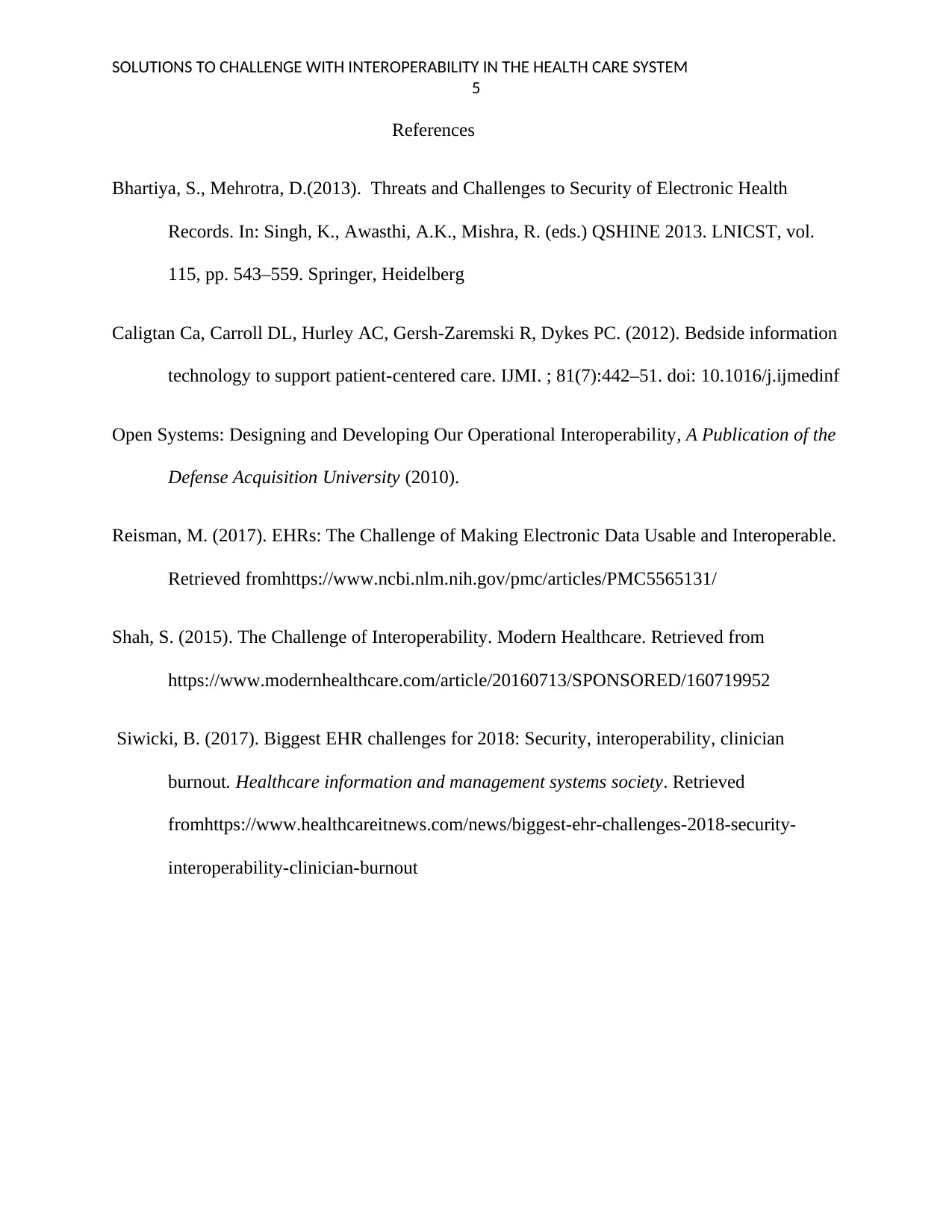
SOLUTIONS TO CHALLENGE WITH INTEROPERABILITY IN THE HEALTH CARE SYSTEM
5
References
Bhartiya, S., Mehrotra, D.(2013). Threats and Challenges to Security of Electronic Health
Records. In: Singh, K., Awasthi, A.K., Mishra, R. (eds.) QSHINE 2013. LNICST, vol.
115, pp. 543–559. Springer, Heidelberg
Caligtan Ca, Carroll DL, Hurley AC, Gersh-Zaremski R, Dykes PC. (2012). Bedside information
technology to support patient-centered care. IJMI. ; 81(7):442–51. doi: 10.1016/j.ijmedinf
Open Systems: Designing and Developing Our Operational Interoperability, A Publication of the
Defense Acquisition University (2010).
Reisman, M. (2017). EHRs: The Challenge of Making Electronic Data Usable and Interoperable.
Retrieved fromhttps://www.ncbi.nlm.nih.gov/pmc/articles/PMC5565131/
Shah, S. (2015). The Challenge of Interoperability. Modern Healthcare. Retrieved from
https://www.modernhealthcare.com/article/20160713/SPONSORED/160719952
Siwicki, B. (2017). Biggest EHR challenges for 2018: Security, interoperability, clinician
burnout. Healthcare information and management systems society. Retrieved
fromhttps://www.healthcareitnews.com/news/biggest-ehr-challenges-2018-security-
interoperability-clinician-burnout
5
References
Bhartiya, S., Mehrotra, D.(2013). Threats and Challenges to Security of Electronic Health
Records. In: Singh, K., Awasthi, A.K., Mishra, R. (eds.) QSHINE 2013. LNICST, vol.
115, pp. 543–559. Springer, Heidelberg
Caligtan Ca, Carroll DL, Hurley AC, Gersh-Zaremski R, Dykes PC. (2012). Bedside information
technology to support patient-centered care. IJMI. ; 81(7):442–51. doi: 10.1016/j.ijmedinf
Open Systems: Designing and Developing Our Operational Interoperability, A Publication of the
Defense Acquisition University (2010).
Reisman, M. (2017). EHRs: The Challenge of Making Electronic Data Usable and Interoperable.
Retrieved fromhttps://www.ncbi.nlm.nih.gov/pmc/articles/PMC5565131/
Shah, S. (2015). The Challenge of Interoperability. Modern Healthcare. Retrieved from
https://www.modernhealthcare.com/article/20160713/SPONSORED/160719952
Siwicki, B. (2017). Biggest EHR challenges for 2018: Security, interoperability, clinician
burnout. Healthcare information and management systems society. Retrieved
fromhttps://www.healthcareitnews.com/news/biggest-ehr-challenges-2018-security-
interoperability-clinician-burnout
1 out of 5
Related Documents
Your All-in-One AI-Powered Toolkit for Academic Success.
+13062052269
info@desklib.com
Available 24*7 on WhatsApp / Email
![[object Object]](/_next/static/media/star-bottom.7253800d.svg)
Unlock your academic potential
Copyright © 2020–2025 A2Z Services. All Rights Reserved. Developed and managed by ZUCOL.




